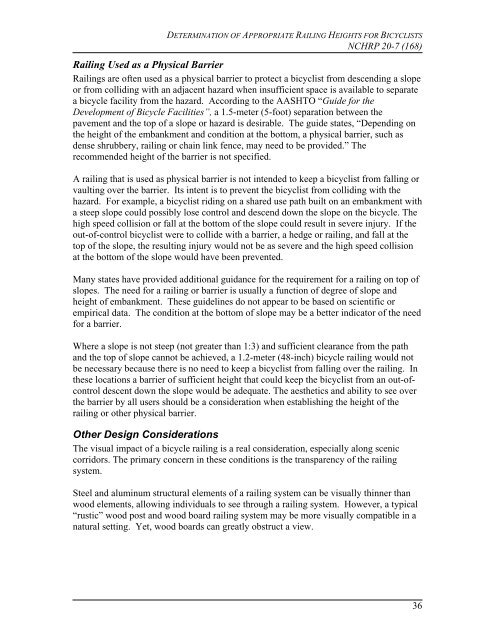Bicycle Railing Height Report - AASHTO - Subcommittee on Design
Bicycle Railing Height Report - AASHTO - Subcommittee on Design
Bicycle Railing Height Report - AASHTO - Subcommittee on Design
Create successful ePaper yourself
Turn your PDF publications into a flip-book with our unique Google optimized e-Paper software.
DETERMINATION OF APPROPRIATE RAILING HEIGHTS FOR BICYCLISTS<br />
NCHRP 20-7 (168)<br />
<str<strong>on</strong>g>Railing</str<strong>on</strong>g> Used as a Physical Barrier<br />
<str<strong>on</strong>g>Railing</str<strong>on</strong>g>s are often used as a physical barrier to protect a bicyclist from descending a slope<br />
or from colliding with an adjacent hazard when insufficient space is available to separate<br />
a bicycle facility from the hazard. According to the <str<strong>on</strong>g>AASHTO</str<strong>on</strong>g> “Guide for the<br />
Development of <str<strong>on</strong>g>Bicycle</str<strong>on</strong>g> Facilities”, a 1.5-meter (5-foot) separati<strong>on</strong> between the<br />
pavement and the top of a slope or hazard is desirable. The guide states, “Depending <strong>on</strong><br />
the height of the embankment and c<strong>on</strong>diti<strong>on</strong> at the bottom, a physical barrier, such as<br />
dense shrubbery, railing or chain link fence, may need to be provided.” The<br />
recommended height of the barrier is not specified.<br />
A railing that is used as physical barrier is not intended to keep a bicyclist from falling or<br />
vaulting over the barrier. Its intent is to prevent the bicyclist from colliding with the<br />
hazard. For example, a bicyclist riding <strong>on</strong> a shared use path built <strong>on</strong> an embankment with<br />
a steep slope could possibly lose c<strong>on</strong>trol and descend down the slope <strong>on</strong> the bicycle. The<br />
high speed collisi<strong>on</strong> or fall at the bottom of the slope could result in severe injury. If the<br />
out-of-c<strong>on</strong>trol bicyclist were to collide with a barrier, a hedge or railing, and fall at the<br />
top of the slope, the resulting injury would not be as severe and the high speed collisi<strong>on</strong><br />
at the bottom of the slope would have been prevented.<br />
Many states have provided additi<strong>on</strong>al guidance for the requirement for a railing <strong>on</strong> top of<br />
slopes. The need for a railing or barrier is usually a functi<strong>on</strong> of degree of slope and<br />
height of embankment. These guidelines do not appear to be based <strong>on</strong> scientific or<br />
empirical data. The c<strong>on</strong>diti<strong>on</strong> at the bottom of slope may be a better indicator of the need<br />
for a barrier.<br />
Where a slope is not steep (not greater than 1:3) and sufficient clearance from the path<br />
and the top of slope cannot be achieved, a 1.2-meter (48-inch) bicycle railing would not<br />
be necessary because there is no need to keep a bicyclist from falling over the railing. In<br />
these locati<strong>on</strong>s a barrier of sufficient height that could keep the bicyclist from an out-ofc<strong>on</strong>trol<br />
descent down the slope would be adequate. The aesthetics and ability to see over<br />
the barrier by all users should be a c<strong>on</strong>siderati<strong>on</strong> when establishing the height of the<br />
railing or other physical barrier.<br />
Other <strong>Design</strong> C<strong>on</strong>siderati<strong>on</strong>s<br />
The visual impact of a bicycle railing is a real c<strong>on</strong>siderati<strong>on</strong>, especially al<strong>on</strong>g scenic<br />
corridors. The primary c<strong>on</strong>cern in these c<strong>on</strong>diti<strong>on</strong>s is the transparency of the railing<br />
system.<br />
Steel and aluminum structural elements of a railing system can be visually thinner than<br />
wood elements, allowing individuals to see through a railing system. However, a typical<br />
“rustic” wood post and wood board railing system may be more visually compatible in a<br />
natural setting. Yet, wood boards can greatly obstruct a view.<br />
36


